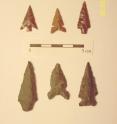Cutting-edge weapons result of prehistoric experimentation
In today's fast-paced, technologically advanced world, people often take the innovation of new technology for granted without giving much thought to the trial-and-error experimentation that makes technology useful in everyday life. When the "cutting-edge" technology of the bow and arrow was introduced to the world, it changed the way humans hunted and fought. University of Missouri archaeologists have discovered that early man, on the way to perfecting the performance of this new weapon, engaged in experimental research, producing a great variety of projectile points in the quest for the best, most effective system. "Technological innovation and change has become a topic that interests people," said R. Lee Lyman, professor and chair of the University of Missouri Department of Anthropology. "When the bow and arrow appeared in North America, roughly 1,500 years ago, it eventually replaced the atlatl (spear thrower) and dart. The introduction of the bow and arrow, a different weapon delivery system, demanded some innovative thinking and technology. In other words, one could not just shoot a dart from a bow. Components like the shaft and arrow point needed to be reinvented."
Because the necessary flight dynamics and mechanics of the arrow wouldn't have been fully understood, the indigenous people at the time would have experimented—trying all sorts of points with different types of shafts, attempting to discover the best combinations. This reinvention process can be seen archaeologically through an increase in the number and variation of projectile points—indicating the transition period between the atlatl and the bow and arrow.
"Everyone is looking for the better mouse trap," Lyman said. "Once a change is made in one variable, it may prompt changes in another variable because the two are mechanically linked. For example, if something gets longer, generally, it will get heavier. This is called a cascade effect. This, in combination with experimentation, resulted in the tremendous variation in projectile points."
Lyman said there is evidence of an initial burst of variation in projectile points at the time bow-and-arrow technology was introduced and that prehistoric artisans experimentally sought arrow points that worked effectively. Following that initial burst, less-effective projectile models were discarded, causing archaeologists to see a reduction in variation.
Source: University of Missouri-Columbia
Other sources
- Prehistoric beta testing led to perfected weaponsfrom Science BlogWed, 11 Jun 2008, 3:28:19 UTC
- Early Humans Experimented To Get Bow And Arrow Just Right, Findings Suggestfrom Science DailyTue, 10 Jun 2008, 23:08:01 UTC
- Cutting-edge weapons result of prehistoric experimentationfrom PhysorgTue, 10 Jun 2008, 20:49:17 UTC
